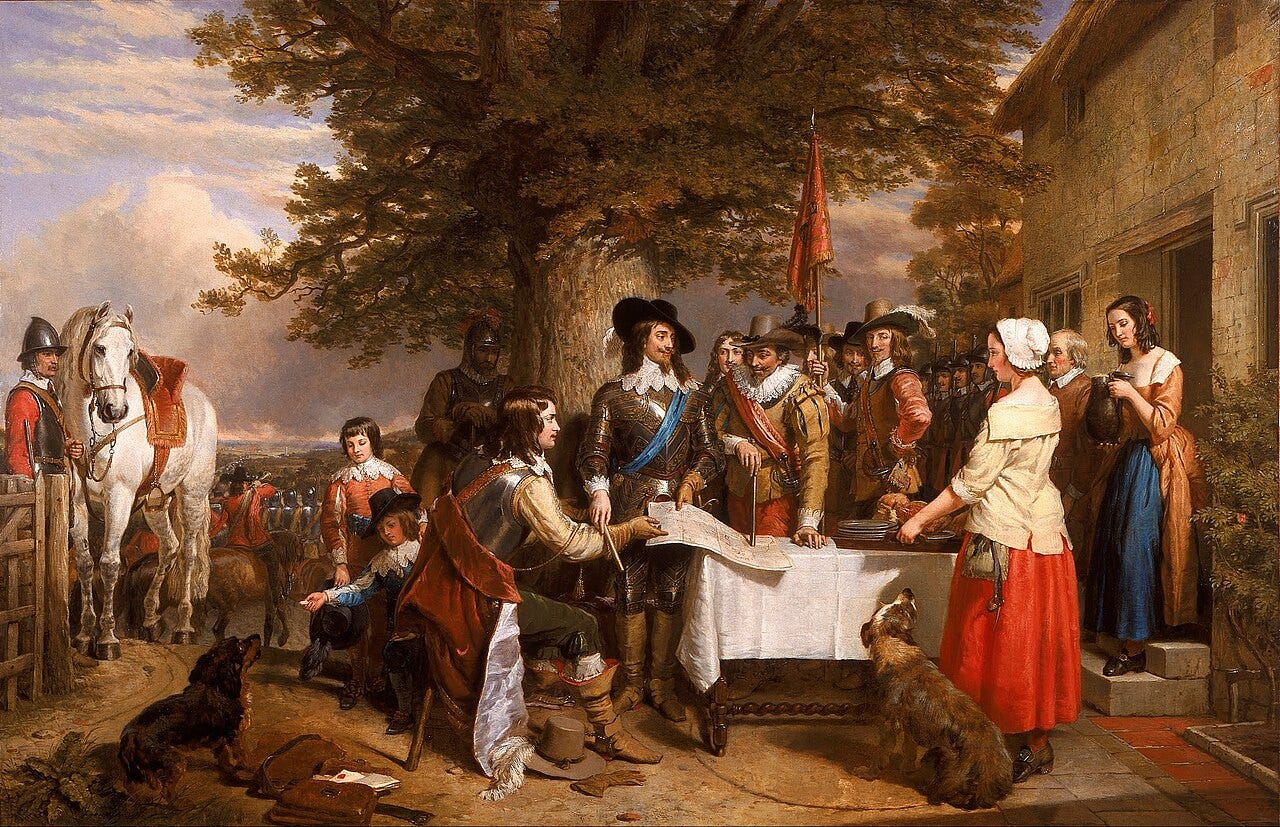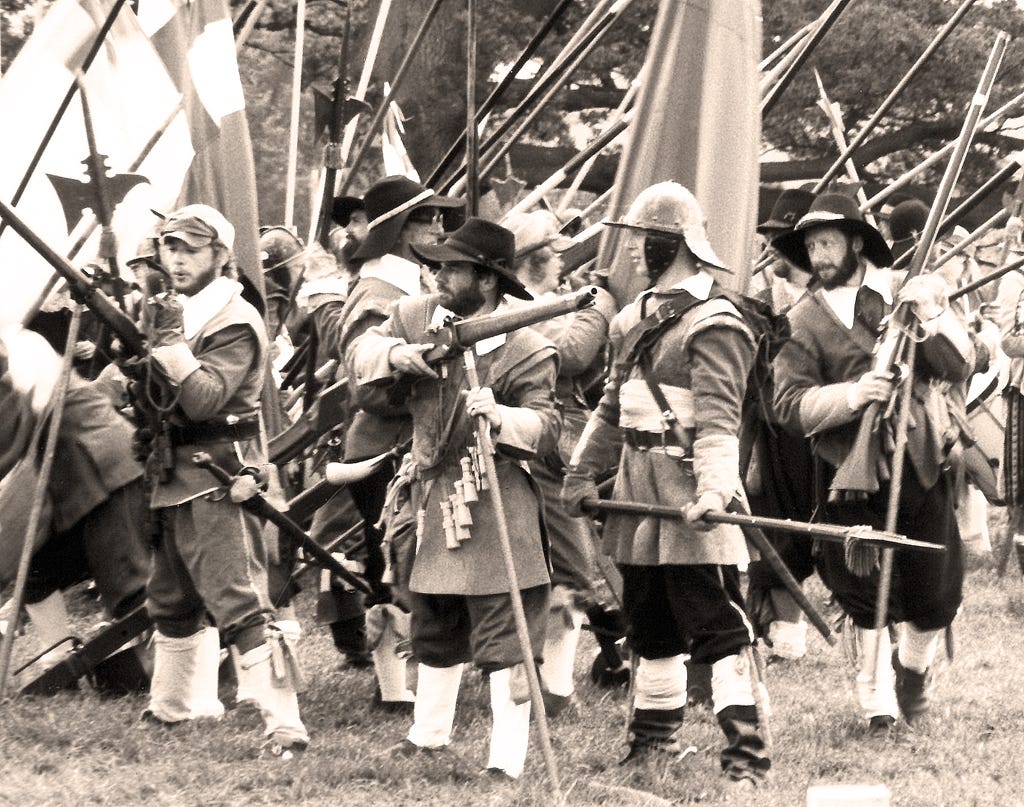The First English Civil War was one of a series of conflicts in the British Isles in the middle of the seventeenth century that are sometimes referred to as the Wars of the Three Kingdoms. This fighting took place in the British Isles between supporters of the monarchy of Charles I and his son and successor, Charles II and opposing groups in their kingdoms, including Parliamentarians in England, Covenanters in Scotland, and Confederates in Ireland. The supporters of Charles were known as Royalists or Cavaliers, while the opposition in England were Parliamentarians, also known as Roundheads for their short-cropped hair, in contrast to the long hair and wigs associated with the Cavaliers. The origins of the conflict are complicated but included long and short-term issues around politics, religion, tax and the personality of the king.
The English Civil Wars are traditionally considered to have begun in England in August 1642, when Charles I raised an army against the wishes of Parliament, ostensibly to deal with a rebellion in Ireland. However, related conflict in the British Isles had already begun in Scotland and Ireland. Both sides spent 1642 vying for recruits, supplies and territory. Following a series of skirmishes, the first major engagement of the conflict was the Battle of Edgehill in October 1642. By the end of 1642 each side had armies of around 60-70,000 men in the field. As the war carried on it became a conflict of sieges and skirmishes, rather than pitched battles, as local garrisons scrambled for control. Charles, who had fled London in 1641, made his headquarters in Oxford with support in the north and west of England and in Wales. Parliament controlled the wealthier areas in the south and east of England along with most of the key ports and London, the financial capital of the kingdom.
Charles Landseer, ‘The Eve of the Battle of Edge Hill, 1642’. Public Domain.
While Charles prevented the Parliamentarians from defeated his main field, Parliament prevented Charles from taking London. A stalemate ensued. Parliamentary success at the Battle of Marston Moor in July 1644 was a decisive victory which also led reform of the Parliamentary armies with the creation of the New Model Army, completed in April 1645. This was the first standing army in England, with central funding and direction. It would turn the tide of the war.
The New Model Army won a major success against the Royalist forces at the Battle of Naseby in June 1645. It marked the start of a string of stunning successes turning the war in Parliament’s favour that eventually forced the king to surrender to Scottish forces at Newark in May 1646 leading to the end of this particular conflict.
It is doubtful whether Parliament would have won the war without Scottish intervention. Royalist success in England in early 1643, combined with the prospect of aid from Ireland for the king, prompted the Scottish Covenanters to sign a political, military, and religious alliance, Solemn League and Covenant, with the English Parliamentarians. Anxious to protect their revolution at home, the Covenanters insisted upon the establishment of Presbyterianism in England. In return they agreed to send an army of 21,000 men to serve there. These troops played a critical role at Marston Moor. For his part, Charles looked to Ireland for support. However, the Irish troops that finally arrived in Wales never equalled the Scottish presence, while the king’s willingness to secure aid from Catholic Ireland damaged his reputation in England.
Colin Howley, Sealed Knot re-enactment of the English Civil War (CC BY-ND 2.0)
The First English Civil War was the largest of the many interrelated conflicts that occurred in the British Isles in the middle of the seventeenth century. It had a significant impact on England at this time as well as subsequent English history. Its story is complex, which is perhaps why it is relatively less well known in the public sphere than other periods of history (while being the focus of a huge amount of academic study). Even for historians not interested in the military and political events of this conflict it is important to consider the impact on our own areas of research, for example our family and local history. This is especially so as it greatly affected the lives of many who lived during this time. It also affected the types and number of records which were made and survive for us to research people and places in these decades.
References and Resources:
Information from this post was taken from Jane H. Ohlmeyer, ‘English Civil Wars’, https://www.britannica.com/event/English-Civil-Wars
Michael Braddick, God’s Fury, England’s Fire: A New History of the English Civil Wars (2009)
Blair Worden, The English Civil Wars: 1640-1660 (2010)
British Civil Wars, Commonwealth and Protectorate Project, http://bcw-project.org/
English Civil War, a hub for resources, comment and discussion, concentrating primarily on the conflict in England 1642-1649, https://www.englishcivilwar.org/
Civil War Petitions: Conflict, Welfare and Memory during and after the English Civil Wars, 1642 – 1710, https://www.civilwarpetitions.ac.uk/
The World Turned Upside Down is a unique resource telling the stories of the people, events and ideas of the British Civil Wars, https://www.worldturnedupsidedown.co.uk/







A good summary of a highly turbulent time in English history, with profound consequences for England (and beyond).